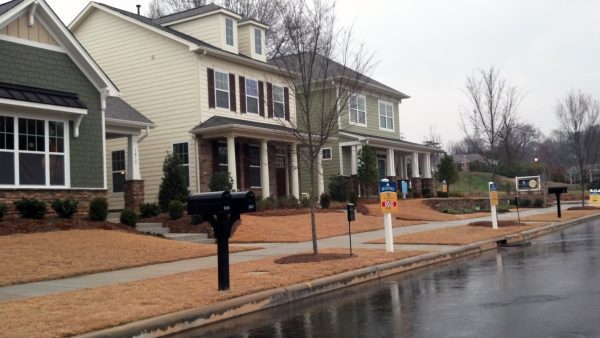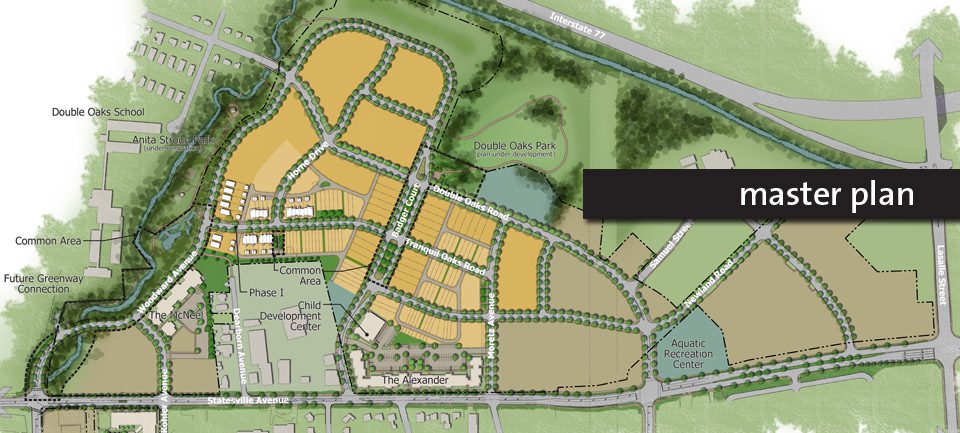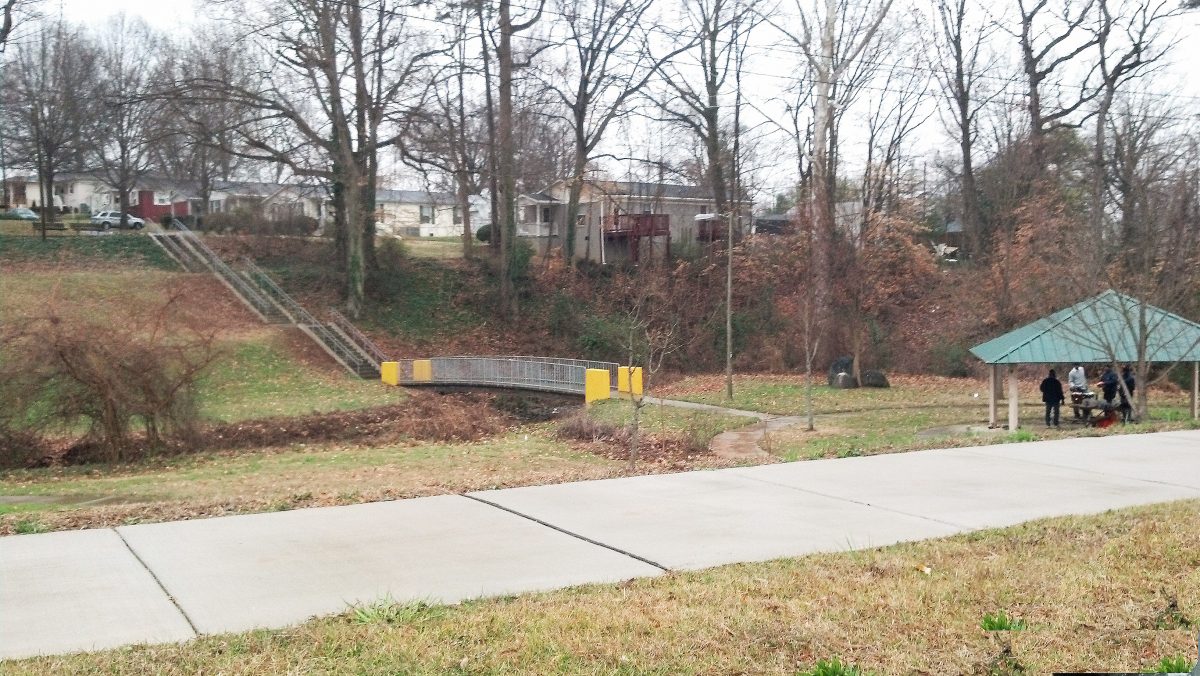Brightwalk, new community with green heart

Brightwalk is unique among Charlotte’s new developments.
Part of that is size and location. It’s on 98 acres of redeveloped infill property along Statesville Avenue, about 2 miles from uptown. It will offer more than 1,000 single-family homes, townhomes and apartments – including senior housing and a day-care facility, all of it arranged around green spaces and tree-lined streets.
It’s a collaborative effort among the nonprofit Charlotte Mecklenburg Housing Partnership, Standard Pacific Homes, and the city of Charlotte, which has invested $25 million – not a standard development arrangement. Brightwalk occupies a brownfield site formerly home to the Double Oaks low-income apartment development in the southern part of the Druid Hills neighborhood. The new homes are aimed at working families with mixed income levels. That, too, is unusual – but not unprecedented – for a large development project in the Charlotte region.

What also sets Brightwalk apart is its partnership with the McColl Center for Visual Art, which will make environmental art a central part of the new development. McColl Center president Suzanne Fetscher, said the center has plans for eight to 11 environmental artists-in-residence at Brightwalk over the next three to five years. “We’re really excited about what the possibilities are in engaging artists in the community here,” Fetscher said at the development’s Feb. 14 ribbon-cutting ceremonies. “They’ll be working in these 14 acres of green space, doing environmental projects that address sustainability and mitigation.”
(What’s environmental art? See this article.)
Environmental artists Daniel McCormick and Mary O’Brien prepared a master plan for environmental and ecological art for the Brightwalk community. They’ve been involved in other projects in Charlotte, including a watershed sculpture project in Freedom Park, and are co-directors of the McColl Center’s environmental artist-in-residence program.
The art being planned at Brightwalk isn’t art for art’s sake, either. It will also provide curriculum for Charlotte-Mecklenburg Schools as an “outdoor classroom and laboratory,” and will include water reclamation projects. Fetscher envisions “pockets of wonder with nature, flowers, and all sorts of wonderful things growing.”
I tracked down McCormick and O’Brien in a swamp in Louisiana, where they were working on a restoration installation to protect newly planted bald cypress seedlings from an invasive aquatic rodent called a river rat or nutria. They see the environmental features of Brightwalk as a way to build a sustainable community.
“Environmental restoration and sustainable art goes along with that. Looking forward to future generations, this allows the community to not have to be torn down in 50 years,” McCormick said in a phone interview. “This happens a lot in Charlotte, where things seems to be built that way.”
 Some of the environmental art will be large installations, and some will be small – like in its sidewalks or rain gutters. “We have made a lot of suggestions to focus on the open areas – parks, median strips, the creek and a wetlands area,” McCormick and O’Brien explained. “There will likely be some kind of community-based consensus with the developers on these projects. This will be one of its biggest breakthroughs; not just objects around their environment, but residents involved in selecting areas where the art will be implemented. This is also where the artist comes in, who will likely play a leadership role from an outside perspective, but the community will be active in having a new kind of social experience.”
Some of the environmental art will be large installations, and some will be small – like in its sidewalks or rain gutters. “We have made a lot of suggestions to focus on the open areas – parks, median strips, the creek and a wetlands area,” McCormick and O’Brien explained. “There will likely be some kind of community-based consensus with the developers on these projects. This will be one of its biggest breakthroughs; not just objects around their environment, but residents involved in selecting areas where the art will be implemented. This is also where the artist comes in, who will likely play a leadership role from an outside perspective, but the community will be active in having a new kind of social experience.”
Art aside, how does a new neighborhood meld into a well-established, older city community? I posed this question to long-time resident William Gaston, 61, whom I met when he rode up to the Brightwalk sales center on a green, classic Schwinn bicycle with big, white-wheel tires.
“I’ve lived in this community since the mid-1950s and went to Double Oaks Elementary School,” said Gaston. “I like the new development. Sure, it has its positives and negatives, and some people here think it may increase their taxes. But that’s just part of life,” he said. “For the most part, people love it. And we are really looking forward to the new aquatic center,” which will reoccupy the site of the old Double Oaks pool.
Gaston recalled that the Brightwalk site used to provide apartments with affordable rents to returning World War II veterans. A lot of seniors have also called this spot home, many of who may not be able to move back.
 A green vision is key to the master plan, which includes renovations to nearby Double Oaks Park and Anita Stroud Park. The area’s parks and mature trees have been an enduring part of the neighborhood as it changed over the years. Many of the site’s stately trees were carefully saved, and will help to unite the new residences with the surrounding community. Debris from the demolition of the older buildings on the site was recycled as subgrade for new streets. Markings on storm drains caution that all dumping into the drainage system makes its way into local waterways.
A green vision is key to the master plan, which includes renovations to nearby Double Oaks Park and Anita Stroud Park. The area’s parks and mature trees have been an enduring part of the neighborhood as it changed over the years. Many of the site’s stately trees were carefully saved, and will help to unite the new residences with the surrounding community. Debris from the demolition of the older buildings on the site was recycled as subgrade for new streets. Markings on storm drains caution that all dumping into the drainage system makes its way into local waterways.
The county-owned parks surrounding Brightwalk have stairs and paths coming from both directions – providing a type of shared front porch for the new community and its neighbors. “I see the whole development as embracing the surrounding communities. The parks, the future aquatic center – I’m glad it’s here,” said Gaston. “I think this development is long overdue.”
At Brightwalk’s ribbon cutting, Mayor Anthony Foxx talked about the neighborhood changes. “When you come to Brightwalk today, you don’t see dilapidated housing and despair, you see reinvention and hope. It happened because a community around us understood that if we could make this place just a little brighter, we could make the entire area a little brighter.”
Brightwalk, he said, “says that no area of our community has to take deterioration as an everyday experience; that we as a community can build up our neighborhoods and in the process build up our people, and in the process build up our city.”